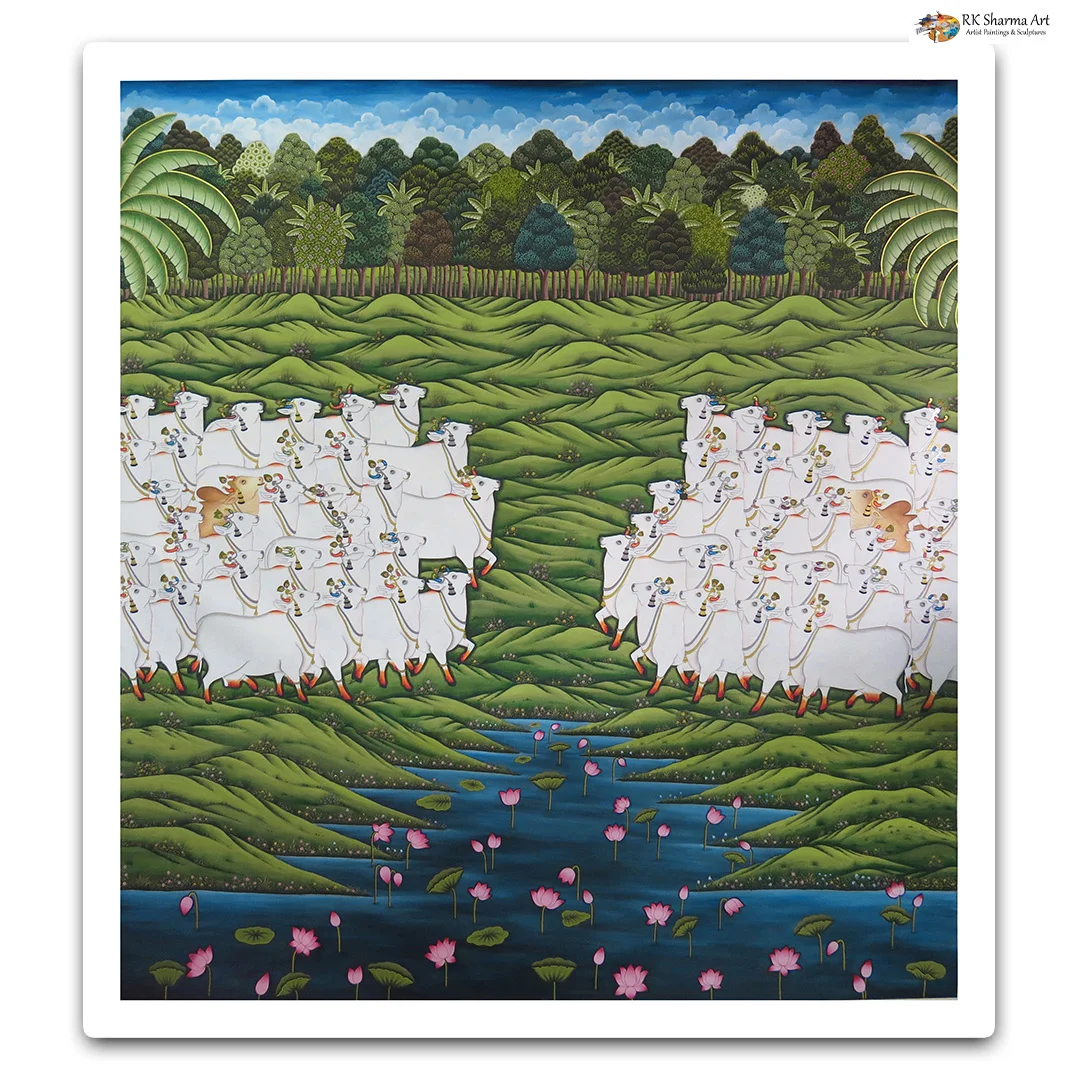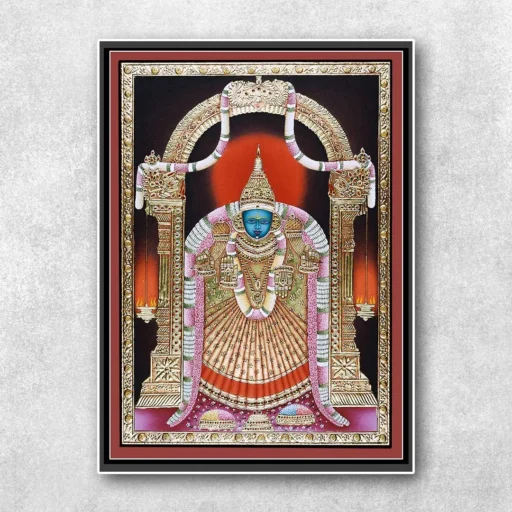In the rich tapestry of Indian art, Pichwai painting stand out as luminous expressions of devotion and craftsmanship. As we embark on this exploration, we delve into the captivating world of a top Pichwai painting artist, unraveling the intricate artistry, cultural significance, and mesmerizing radiance that emanates from each canvas.
Pichwai Painting: A Cultural Tapestry Unfolded
Originating from the holy town of Nathdwara in Rajasthan, Top Pichwai painting have been an integral part of the Pushtimarg tradition since the 17th century. These intricate artworks traditionally adorned the walls of temples, especially as backdrops for the worship of Lord Krishna, depicting various aspects of his life, particularly his pastoral escapades in Vrindavan.
Pichwai, which translates to ‘behind the idol’ in Sanskrit, encapsulates the essence of these paintings as they serve as decorative backdrops for the deity’s idol during different seasons, festivals, and moods. The meticulous detailing, vibrant colors, and spiritual themes make Pichwai paintings a captivating form of visual storytelling.
Mastery in Brushstrokes: The Artistry Unveiled
At the heart of Top Pichwai painting lies the mastery of the artist, whose skilled hand transforms a blank canvas into a resplendent narrative. The top Pichwai painting artist, with a deep understanding of the traditional techniques and a flair for innovation, breathes life into the canvas with each brushstroke.
The meticulous nature of Top Pichwai painting demands patience, precision, and a profound connection with the subject matter. Artists intricately depict scenes from Lord Krishna’s life, capturing the divine playfulness, the mesmerizing Raas Leela, and the pastoral beauty of Vrindavan. The use of bold, vibrant colors, often derived from natural pigments, contributes to the visual richness that defines Pichwai art.
Themes That Illuminate: Unraveling Spiritual Narratives
Central to Pichwai paintings is their ability to narrate spiritual stories and convey a sense of devotion. Each painting is a visual hymn, capturing the essence of the Bhakti movement and the adoration of Lord Krishna. From the divine love between Radha and Krishna to the exuberant festivities of Janmashtami, the themes explored in Pichwai paintings resonate with the soul’s yearning for the divine.
Top Pichwai painting artists infuse their work with a sense of reverence, and every stroke is a homage to the spiritual significance of the subject. The intricately portrayed motifs, such as lotus flowers, peacocks, and the sacred cows, contribute to the overall narrative, weaving a visual tapestry that transcends the mundane and invites the viewer into the realm of the divine.
Color Palette of the Divine: Illuminating the Canvas
The color palette employed in Top Pichwai painting is a feast for the eyes and a reflection of the artist’s nuanced understanding of color symbolism. Deep blues, vibrant reds, lush greens, and shimmering gold leaf are meticulously applied to create a visual symphony that mirrors the divine aesthetics associated with Lord Krishna.
Blue, often representing the cosmic and the infinite, is prominently featured, symbolizing the divine nature of Lord Krishna. The use of gold leaf adds a celestial glow, elevating the entire painting to a state of ethereal radiance. The juxtaposition of these colors creates a harmonious visual experience, inviting viewers to immerse themselves in the divine aura emanating from the canvas.
Evolution and Innovation: Honoring Tradition with a Contemporary Touch
While Top Pichwai painting are rooted in tradition, top artists in this genre bring innovation to their work, ensuring the art form remains dynamic and relevant in contemporary times. Artists may experiment with compositions, introduce modern elements, or infuse a personal touch while maintaining the core spiritual themes.
Contemporary Pichwai artists find a delicate balance between preserving the sanctity of tradition and expressing their individual creativity. This nuanced approach ensures that Pichwai paintings continue to captivate both traditional art enthusiasts and those with a more modern aesthetic sensibility.
The Spiritual and Commercial Nexus: Pichwai Art in the Modern Context
In the modern context, Top Pichwai painting have transcended the sacred confines of temples to grace art galleries, museums, and private collections worldwide. The allure of these exquisite artworks extends beyond spiritual devotion; they are sought after for their aesthetic beauty and cultural richness.
Top Pichwai painting artists find themselves navigating the nexus between the spiritual and the commercial. While remaining true to the sacred roots of their art, they also recognize the global appreciation for Pichwai paintings, leading to collaborations, exhibitions, and a broader audience for this traditional Indian art form.
Preserving Tradition: Challenges and Triumphs
Preserving the tradition of Top Pichwai painting comes with its own set of challenges. The intricate techniques, the time-consuming nature of the art, and the need for skilled artisans contribute to the rarity and preciousness of authentic Pichwai creations. The transmission of this art from one generation to the next is crucial for its continuity.
Organizations and initiatives focused on cultural preservation play a vital role in sustaining Pichwai art. Workshops, apprenticeships, and collaborative efforts between artists and institutions contribute to the ongoing legacy of this traditional Indian art form.
The Legacy of Top Pichwai Painting Artists: Inspiration for Generations
Top Pichwai painting artists not only create exquisite artworks but also become custodians of a rich cultural heritage. Their legacy extends beyond individual paintings; it becomes a source of inspiration for aspiring artists and a bridge that connects generations.
Through mentorship, educational initiatives, and public engagements, these artists contribute to the perpetuation of Pichwai art. Their commitment to tradition, coupled with a willingness to evolve, ensures that the radiance of Pichwai painting continues to illuminate the artistic landscape for generations to come.
Conclusion: A Luminous Tapestry Unfurls
As we unveil the mastery of top Top Pichwai painting artists, we witness more than just a visual feast of colors and intricate details. We witness a sacred tradition that has transcended time, a craftsmanship that illuminates the divine, and an art form that invites viewers into a realm of spiritual contemplation.
In the hands of these skilled artisans, a canvas becomes a sacred space where devotion and creativity converge. Each stroke of the brush is a prayer, and every color is a hymn, resonating with the rich cultural heritage of India. Pichwai paintings, in their radiant splendor, continue to be a testament to the timeless beauty that emerges when art becomes a vessel for the sacred and the sublime.


